Mongolian Beef
- By Jennifer Segal
- Updated April 22, 2025
- 54 Comments
- Leave a Review

This post may contain affiliate links. Read my full disclosure policy.
Why wait for delivery? This homemade Mongolian beef recipe comes together fast with thinly sliced steak and a bold, savory-sweet sauce—perfect over rice and ready in under an hour!
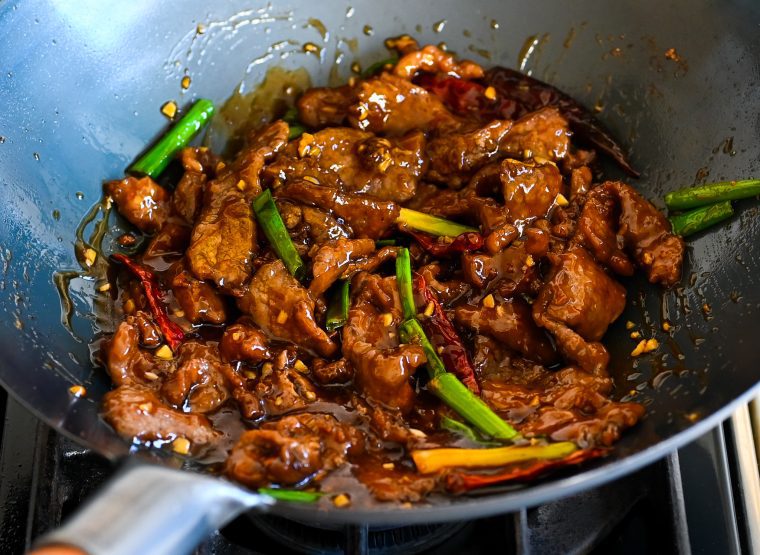
Mongolian beef is a Chinese-American takeout classic made with tender, crispy beef tossed in a savory-sweet brown sauce. This version comes from The Woks of Life, written by Bill, Judy, Kaitlin, and Sarah Leung, the family behind the popular Woks of Life blog. I’m a big fan of the cookbook and the blog—they’re excellent resources for anyone interested in learning more about Chinese cooking.
The dish starts with thinly sliced flank steak, which is “velveted”—a technique that involves marinating the beef in a mixture that includes baking soda to tenderize it—then coated in cornstarch. The beef is shallow-fried in a wok or skillet until golden and crispy, then tossed in a flavorful sauce made with soy sauce, brown sugar, garlic, ginger, and scallions. Served over steamed rice, it’s a total family-pleaser—and every bit as good as the Mongolian beef you’d get at your favorite Chinese restaurant.
“The crispiness of the meat was perfect, and the flavors blended beautifully. I stir-fried some broccoli florets just to have veggies with it and garnished with sesame seeds. Love!!”
What You’ll Need To Make Mongolian Beef
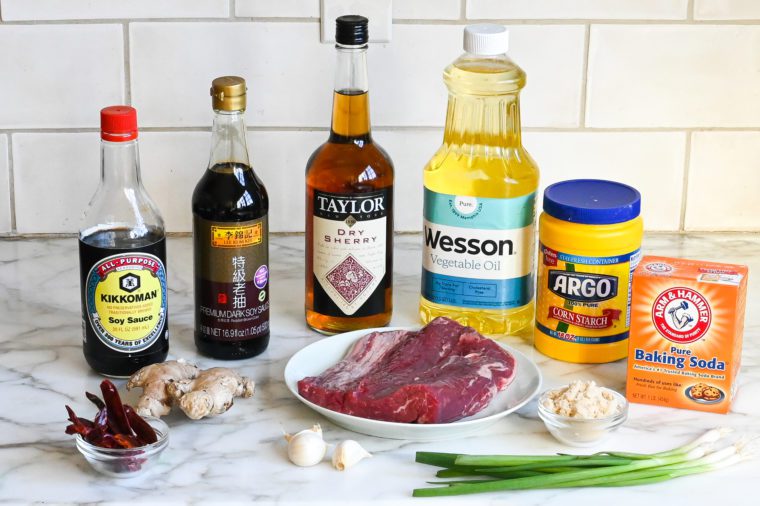
- Beef Flank Steak: Flank steak’s lean texture and grain make it perfect for quick stir-fries like this. Cutting the steak into thin strips helps it cook quickly and stay tender, while also allowing the sauce to coat each piece evenly.
- Vegetable Oil: Used in a few steps—first in the marinade, then for frying the beef, and finally for stir-frying the aromatics. Another neutral oil like canola or grapeseed also works well.
- Soy Sauce (Regular and Dark): Regular soy sauce brings classic salty, umami flavor, while dark soy sauce is thicker, a little sweeter, and gives the sauce a deeper color. You can find dark soy sauce at Asian markets or online. If you don’t have any, you can leave it out (but your dish will be lighter in color), or you can make a quick swap by combining 2 teaspoons soy sauce, 1/2 teaspoon molasses, and 1/8 teaspoon sugar.
- Cornstarch: Cornstarch serves several purposes here—it thickens the sauce to that glossy, restaurant-style finish, gives the beef its crispy coating, and helps keep the meat juicy as it cooks. As a thickener, cornstarch needs to be dissolved in water before adding it to simmering liquid.
- Shaoxing wine: A Chinese rice wine that adds depth and that signature flavor you get from Chinese food. If you don’t have shaoxing wine, dry sherry is an excellent substitute.
- Dried whole red chili peppers: These optional peppers add a smoky, moderate heat and bold flavor to the dish. Often used in Chinese stir-fries, they’re more for infusing the oil than eating whole. Look for them in the produce section or international aisle.
- Baking soda: A secret to making super tender beef. When mixed with water, baking soda creates an alkaline solution that can break down the tough fibers in meat—a technique often used in Chinese cooking called “velveting.”
- Light Brown Sugar: Adds sweetness to balance the savory elements in the sauce and gives it that signature Mongolian beef flavor.
- Fresh Ginger, Garlic & Scallions: Ginger adds warmth, garlic brings a savory punch, and scallions do double duty — the whites get stir-fried with the aromatics, while the greens go in at the end for color and a pop of freshness.
- Jump to the printable recipe for precise measurements
Step-by-Step Instructions
Step 1: Make the marinade and marinate the beef. In a medium bowl, whisk together the Shaoxing wine (or dry sherry), soy sauce, cornstarch, water, and baking soda. Add the beef and stir until evenly coated.

Step 2: Make the sauce. In a small bowl, dissolve the brown sugar in the hot water, then mix in the regular soy sauce and dark soy sauce. (Dissolving the sugar first ensures a smooth sauce with no graininess.)
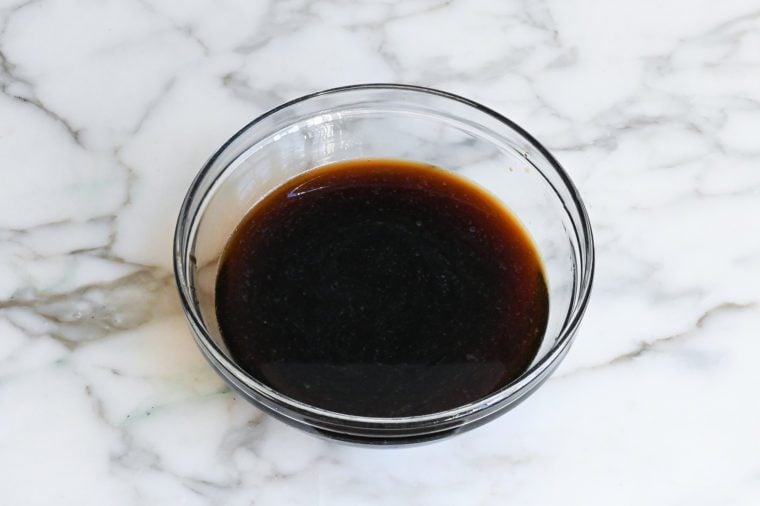
Step 3: Coat the beef. Dredge the marinated beef slices in the ½ cup cornstarch, making sure all sides are covered with the mixture. The cornstarch coating creates a crisp crust when fried and helps the sauce cling to the meat later. Make sure to work in small batches so the beef is evenly coated and doesn’t clump together.
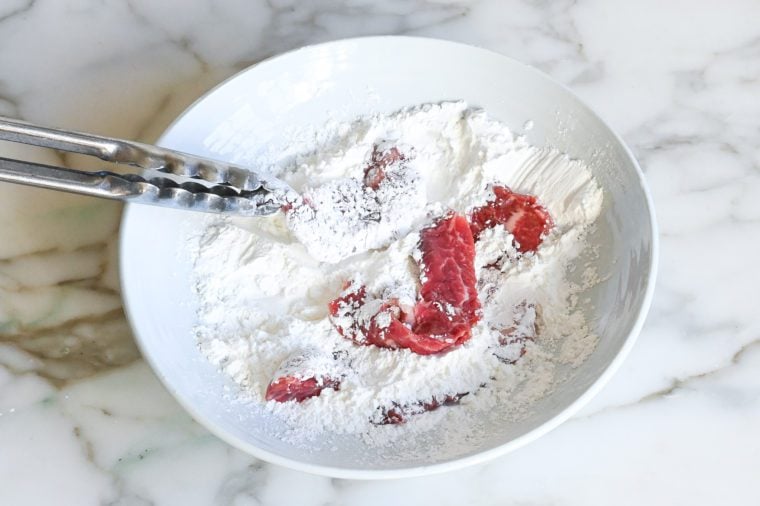
Step 4: Stir-fry the beef. Heat the oil in a wok or large nonstick skillet over high heat until it’s just about to smoke. (High heat is key for getting that signature crispy exterior without overcooking the meat.) Working in batches, spread the beef slices in the pan and shallow-fry them undisturbed for 1 minute per side until they’re browned and crispy. Avoid moving it around too early—letting the beef sear undisturbed helps it develop a golden crust. Transfer to a plate and turn off the heat.
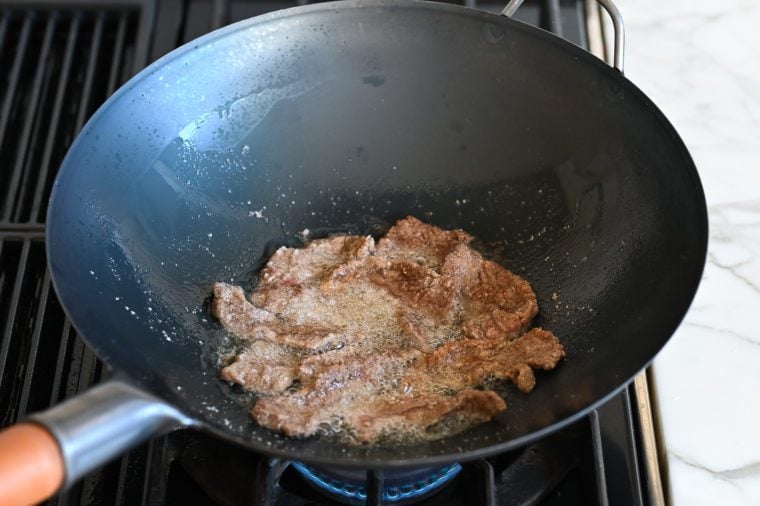
Step 5: Sauté the aromatics. Drain most of the oil, leaving about 1 tablespoon. Wipe out the pan and return it to medium-high heat. Add the ginger and dried chilies (if using) and cook for 15 seconds, then add the garlic and white parts of the scallions and cook for another 15 seconds.
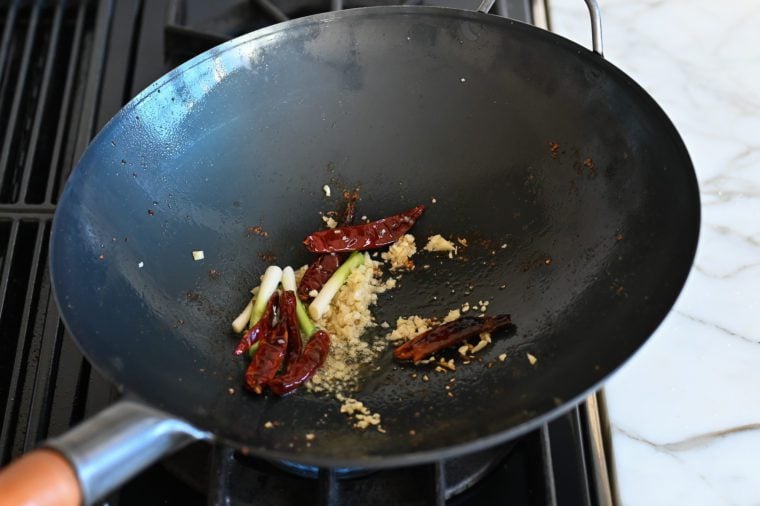
Step 6: Add the sauce. Pour in the sauce and let it simmer for 2 minutes. Meanwhile, stir together the cornstarch and water to make a slurry, then slowly add it to the sauce while stirring. Adding the slurry slowly while stirring prevents lumps and gives you more control over the final consistency.
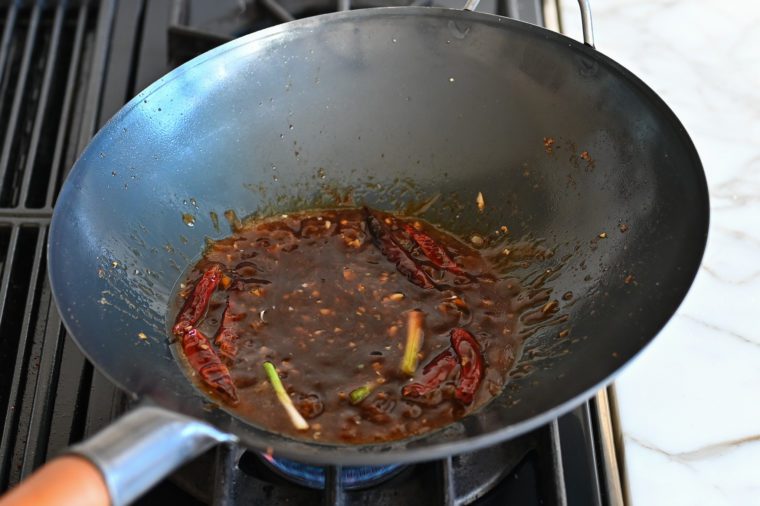
Step 7: Finish and serve. Add the beef and green parts of the scallions to the pan and toss everything together for 30 seconds, until the scallions are wilted and the sauce is glossy with barely any left pooling in the pan. Serve right away and enjoy!

More Chinese Recipes You May Like
Mongolian Beef
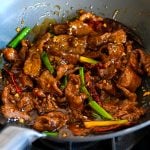
Savory, slightly sweet, and packed with bold flavor, this Mongolian beef recipe hits all the right notes and pairs perfectly with a bowl of steamed rice.
Ingredients
For Marinating the Beef
- 1 pound beef flank steak, sliced against the grain into ¼-inch-thick slices
- 2 teaspoons vegetable (or neutral) oil
- 2 teaspoons Shaoxing wine (or dry sherry)
- 1 teaspoon regular soy sauce
- 1 tablespoon cornstarch
- 1 tablespoon water
- ¼ teaspoon baking soda
For the Sauce
- ¼ cup (packed) light brown sugar
- ¾ cup hot water
- ¼ cup regular soy sauce
- 1 teaspoon dark soy sauce (see note)
For Coating and Searing the Beef
- ½ cup cornstarch
- ⅔ cup vegetable (or neutral) oil
For the Rest of the Dish
- 1 teaspoon minced fresh ginger
- 8 dried red chilies (optional)
- 3 medium garlic cloves, finely chopped
- 4 scallions, white and green parts separated and cut on an angle into 2-inch pieces
- 1½ tablespoons cornstarch
- 2 tablespoons water
Instructions
Marinate the Beef
- In a medium bowl, combine the beef with the oil, Shaoxing wine (or dry sherry), regular soy sauce, cornstarch, water, and baking soda. Marinate for 1 hour.
Make the Sauce
- In a small bowl, dissolve the brown sugar in the hot water. Mix in the regular soy sauce and dark soy sauce.
Coat and Sear the Beef
- In a medium bowl, dredge the marinated beef slices in the ½ cup cornstarch until thoroughly coated.
- Heat the oil in a wok or large nonstick skillet over high heat until just before it starts to smoke. Working in batches so as not to crowd the pan, spread the beef slices evenly in the pan and shallow-fry them undisturbed for 1 minute on each side to achieve a crusty coating. Transfer the beef to a plate and turn off the heat.
Assemble the Dish
- Drain most of the oil from the pan, reserving 1 tablespoon. Wipe the pan clean with a paper towel, then add the reserved tablespoon of oil. Over medium-high heat, add the ginger and whole dried chilies (if using—if you’d like the dish spicier, break 1 or 2 chilies in half). After 15 seconds, add the garlic and the scallion whites. Stir-fry for another 15 seconds. Add the sauce and simmer for 2 minutes.
- In a small bowl, combine the cornstarch with the water to make a slurry, then slowly stir it into the pan.
- Add the beef and the green parts of the scallions. Toss everything together for 30 seconds, until the scallions are wilted and there is almost no standing sauce. Serve.
- Note: Dark soy sauce is saltier, sweeter, and a bit thicker than regular soy sauce. It is used to flavor dishes and also darken the color of sauces, and you only need one to two teaspoons. Dark soy sauce is available at Asian markets or online. If you don’t have any, you can simply omit it. However, your dish will be lighter in color. If you want your dish to look like the photograph, don’t leave it out. (Alternatively, you can make a substitute by combining 2 teaspoons soy sauce, ½ teaspoon molasses, and ⅛ teaspoon sugar.)
Pair with
Nutrition Information
Powered by ![]()
- Per serving (4 servings)
- Calories: 760
- Fat: 60 g
- Saturated fat: 10 g
- Carbohydrates: 31 g
- Sugar: 9 g
- Fiber: 1 g
- Protein: 25 g
- Sodium: 1,149 mg
- Cholesterol: 70 mg
This website is written and produced for informational purposes only. I am not a certified nutritionist and the nutritional data on this site has not been evaluated or approved by a nutritionist or the Food and Drug Administration. Nutritional information is offered as a courtesy and should not be construed as a guarantee. The data is calculated through an online nutritional calculator, Edamam.com. Although I do my best to provide accurate nutritional information, these figures should be considered estimates only. Varying factors such as product types or brands purchased, natural fluctuations in fresh produce, and the way ingredients are processed change the effective nutritional information in any given recipe. Furthermore, different online calculators provide different results depending on their own nutrition fact sources and algorithms. To obtain the most accurate nutritional information in a given recipe, you should calculate the nutritional information with the actual ingredients used in your recipe, using your preferred nutrition calculator.
See more recipes:
Comments
Add a Comment Cancel reply
This site uses Akismet to reduce spam. Learn how your comment data is processed.


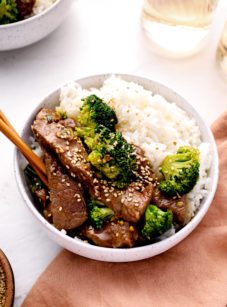


Totally killed my wok
If I make this ahead, will it reheat well?
Hi Debbie, I think this one is best if eaten right after it’s cooked – sorry!
I have not made this yet but am looking forward to trying it Jenn your recipes are always winners. I do have a question about the chili peppers i am having a hard time finding them in my food store can you please share where you purchased yours?
I can usually find them at my regular supermarket – you can also order them on Amazon or go to an Asian market. Hope that helps!
Whenever I need a new recipe the first place I look is Once upon a Chef. People think I can cook.
First made this recipe about 2 years ago and my wife is constantly asking for it. Need I say more?
Outstanding!!!! Our local favorite Chinese restaurant recently closed and every substitute place that we have tried has been a huge disappointment. Thank goodness for Master Chef Jenn! I can’t believe I was able to recreate a dish better than our favorite restaurant! Amazing flavors and easy to follow recipe. Every person in my family ate it, even my pickiest 2 eaters. Beyond 5 stars!!!! The kids said they can’t wait until I make this dish again! I omitted the chilis and used filet mignon instead of flank steak.
I can’t take credit for this one – all props go to the Woks of Life – but so glad you enjoyed it! 🙂
Hi Jenn,
Can you provide a link to your wok? I don’t have one and want one!
Hi Chad, This is the one I have. Hope that helps!
Made this last night and it was delicious! It tasted like a dish from an upscale Chinese restaurant, much better than our local takeout joints. It was a bit more time consuming than I expected, and generated a lot of dishes to clean. Overall, I think I prefer the Korean Bulgogi recipe, especially the skewer version from the cookbook. That is one of my all time favorite OUAC recipes! I think it’s simpler/quicker to make and satisfies the same hankerings as this recipe (and might be even more delicious). But I love exploring Asian recipes in the kitchen, so thanks for this one and the intro to Woks of Life!
Just finished eating this and the whole house is saying “we better have this again” Had to change a couple of things. Didn’t have Sherry so I used Rice Wine and I used a New York steak and added bell peppers and white onion. Thank you for this great recipe.
I’ve had great success with the recipes on your site, and I’m about to try this one. I have a question about the corn starch slurry that is added to the wok after the sauce. The text says to make the slurry with water, but the ingredients in the recipe call for oil. I’ve never made a corn starch slurry with oil–which is it?
Thanks!
Hi BW, It is definitely water; I think you’re looking at another section of the ingredients list that also calls for cornstarch.
How much heat do the chilies add to this recipe? I’m a bit nervous about using them and finding they make it too spicy.
Hi Holly, They are quite hot but they don’t add too much heat to the sauce unless you cut them in half.
Thank you, Jenn! I used them (did not cut in half) and they were not too hot at all. For anyone who is nervous about using them, I would say to go ahead, this was not a spicy recipe. They just add a tiny bit of heat. Overall, this is a fantastic recipe. One of the best Asian dishes I have ever made. I served it with white rice and steamed broccoli, and it was excellent.